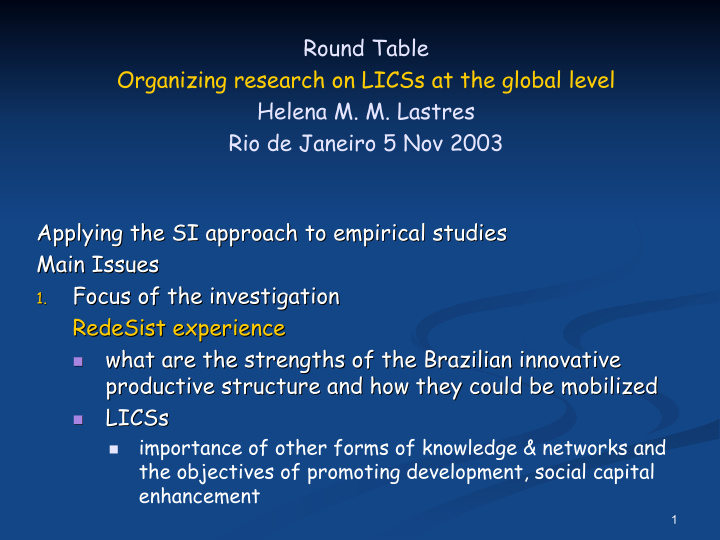



Round Table Organizing research on LICSs at the global level Helena M. M. Lastres Rio de Janeiro 5 Nov 2003 Applying the SI approach to empirical studies Applying the SI approach to empirical studies Main Issues Main Issues Focus of the investigation Focus of the investigation 1. 1. RedeSist experience RedeSist experience what are the strengths of the Brazilian innovative what are the strengths of the Brazilian innovative � � productive structure and how they could be mobilized productive structure and how they could be mobilized LICSs LICSs � � importance of other forms of knowledge & networks and � the objectives of promoting development, social capital enhancement 1
Concepts of system and innovation Concepts of system and innovation 2. 2. SI - - useful focusing device useful focusing device SI � � RedeSist development: local productive and local productive and RedeSist development: � � innovative systems and arrangements - - LPISAs LPISAs innovative systems and arrangements elaboration of a glossary – – GASPIL GASPIL: : � definition of LPISAs + innovation, cooperation, � knowledge, social capital, etc. differences with other concepts, etc … � www.ie.ufrj.br/redesist � 2
Selection of cases Selection of cases 3. 3. criteria: social, economic, technological, political 3. indicators: employment, level of education, sales, taxes, 4. imports & exports of goods and services (including tech), patterns of specialization, infrastructure including (knowledge), regional and national relevance + IPR, etc. Identification of IS 4. problems: � systems are open; cognitive space goes beyond usual focus and � indicators on sectors, individual organizations and space (municipalities and micro-regions) – investigation of the importance of proximity, etc. objectives: � to capture and assess the processes of knowledge creation, � acquisition, use and diffusion processes of learning and competence building � information and knowledge fluxes � 3
Empirical investigation 5. methodology for direct empirical surveys - in refinement � questionnaires, sample and tabular plans targeting � different agents - firms and other organizations dealing with education, training, R&D, promotion, financing, etc. elaboration of technical notes � general structure for the reports (role of the LPISA in � the international, national and local economies, analysis of the case, policy recommendations + IPR regimes, Recuperation and analysis Recuperation and analysis 6. 6. specific conclusions and policy implications � detailed information and local participation in the planning and implementation processes conception of a geo-referenced system of information on � local productive and innovative systems and arrangements - Sinal - www.sinal.redesist.ie.ufrj.br www.sinal.redesist.ie.ufrj.br secondary + primary information � elaboration of a panel summarizing the different types, � forms, location and dynamics of these arrangements, indicating strengths and weaknesses, as well as specific needs 4
Concept of Local Productive and Innovative Systems and Arrangements - LPISAs www.ie.ufrj.br/redesist LPISAs comprise ➮ firms producers of final goods and services, suppliers of firms producers of final goods and services, suppliers of ➮ inputs and equipment, service providers, etc.) and their inputs and equipment, service providers, etc.) and their different forms of representation and association different forms of representation and association ➮ other public and private institutions and organizations other public and private institutions and organizations ➮ specialized in educating and training, R&D, engineering, specialized in educating and training, R&D, engineering, promotion, financing, etc. promotion, financing, etc. Local system are defined as any productive agglomeration Local system involving economic, political and social agents localized in the same area, performing related economic activities and presenting consistent articulation, interaction, co-operation and learning processes Local arrangement s s include productive agglomerations, in which Local arrangement there is no (or almost no) articulation among the agents 5
Recommend
More recommend